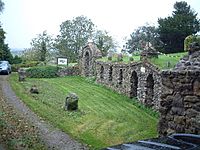Banwell Caves facts for kids
| Site of Special Scientific Interest | |

The Druid's Temple and entrance archway to the Bone Cave
|
|
| Area of Search | Avon |
|---|---|
| Coordinates | 51°19′30″N 2°53′13″W / 51.3249°N 2.8869°W |
| Interest | Biological/Geological |
| Area | 1.7 ha (4.2 acres) |
| Notification | 1963 |
| Banwell Bone Cave | |
|---|---|
| Location | Banwell |
| Depth | 25m |
| Length | 92m |
| Geology | Limestone |
| Cave survey | Mendip Cave Registry & Archive: (1) and (2) |
| Banwell Stalactite Cave | |
|---|---|
| Location | Banwell |
| Depth | 62m |
| Length | 271m |
| Geology | Limestone |
| Cave survey | Mendip Cave Registry & Archive: (1) and (2) |
The Banwell Caves are a special natural area in North Somerset, England. They were officially recognized as a 'Site of Special Scientific Interest' (SSSI) in 1963. This means they are protected because of their unique geology and important wildlife.
The site includes two main caves: the 'Banwell Bone Cave' and the 'Banwell Stalactite Cave'. Both are located on the grounds of a large house at the western end of Banwell Hill. These caves are home to special mineral deposits called barite. You can find more types and amounts of barite here than anywhere else in the Mendip Hills. The caves are also a vital place for greater horseshoe bats to hibernate during winter.
Besides the caves, the area has several interesting old buildings and garden features. These include the Pebble summerhouse, the Druid's Temple, a bone storage building, and Banwell Tower, which was finished in 1840.
Contents
History of the Caves
How the Caves Were Found
The first cave discovered was the Stalactite Cave in 1757. It was opened to visitors in 1824 as a 'show cave'. People paid to see it, and the money helped support the local school.
To make it easier for visitors to get into the Stalactite Cave, workers started digging a tunnel into the hill. During this digging, in 1825, they accidentally found the Bone Cave!
The Bishop's Role
At the time, the estate belonged to George Henry Law, who was the Bishop of Bath and Wells. When many animal bones were found in the Bone Cave, the Bishop believed they were from animals that drowned in a great flood, like the story of Noah's Ark in the Book of Genesis.
The Bishop was very interested in the caves. He had paths and special buildings, called follies, created for visitors to enjoy. He also built a small cottage, which later became his home after he retired.
Protecting the Caves Today
Since the 1970s, people have been working hard to preserve and restore the caves and the surrounding area. This work helps protect these important natural and historical sites for future generations.
Banwell Bone Cave
The Banwell Bone Cave is about 100 m (328 ft) long and 20 m (66 ft) deep. The main Bone Cavern inside is quite large, about 8 m (26 ft) high and wide, and 20 m (66 ft) long. You enter it through a beautiful archway built in the early 1800s.
Ancient Animal Bones
This cave is famous for the many bones found inside. These bones belong to various mammals from the Pleistocene era, which was about 80,000 years ago. Animals like bears, deer, oxen, bison, and reindeer once lived here.
The cave has a large hole in its roof. Scientists believe this hole might have acted like a natural trap, where animals could fall in and get stuck.
Discovery and Excavation
The Bone Cave was found in 1824 while workers were trying to dig a horizontal passage to the Stalactite Cave. An archaeologist named William Beard led some of the early digs. While some bones were taken out for study, many were left inside the cave, stacked up, for visitors to see.
Banwell Stalactite Cave
The Banwell Stalactite Cave is longer than the Bone Cave, measuring about 240 m (787 ft) long and 75 m (246 ft) deep. Even though no stream flows through it now, there's a deep lake in one of its chambers.
Miners first entered the Stalactite Cave in 1757. It was open as a show cave for visitors for many years, from about 1824 to 1864.
Banwell Tower
The Banwell Tower, also known as the Banwell Monument or Banwell Pepperpot, is 18-metre (59 ft) tall. It has three sections and was built in 1840. The tower was made from local stone called lias stone, with some decorative parts made from Bath stone.
During World War II, the tower was used by the Home Guard as a lookout point. By the 1960s, it was in poor condition and hidden by tall trees. However, local groups worked to restore it, and it was reopened to the public in 1996. It is now a Grade II listed building, meaning it's an important historical structure.


